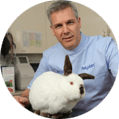Regular teeth brushing helps keep your dog’s gums and teeth clean, which helps prevent and fight gum disease. Here’s why keeping your dog’s teeth clean is so important – plus the method and products you’ll need to get started.
Many dogs show signs of gum disease as early as four years old. This can be down to a combination of issues, including the wrong diet, a lack of suitable chew toys and minimal dental care.
One of the best ways to prevent dental problems like gum disease is by regularly brushing your dog’s teeth. Ideally, you should start brushing your dog’s teeth when they’re a puppy, and gradually build this process into their routine. But if your dog is older, starting to brush their teeth at any age can make a big difference to their oral health.
Why is dog teeth cleaning so important?
Regular brushing helps prevent bacteria and plaque-forming foods from building up on your dog’s teeth. Over time, these can harden to form tartar, which creates uncomfortable deposits, leading to bad breath, gum disease or tooth decay.
When cleaning your dog’s teeth, you can also inspect their mouth for any abnormalities. Showing your vet these as soon as possible can help keep your dog’s mouth healthy. Signs to watch out for include:
- Bad breath
- Discoloured teeth
- Red, sore or bleeding gums
- A build-up of plaque on your dog’s teeth
- Difficulty eating, refusal to eat, or blood in your dog’s food bowl
If you notice any of these signs, it’s best to contact your vet for advice. If your dog is insured with Petplan, you can also use our Pet Expert Chat feature to connect with veterinary experts, 24/7. Simply log in to your My Petplan account to ask for advice about your dog’s dental care.
Dog teeth cleaning products
Cleaning a dog’s teeth is much easier with the right tools. Here’s what to buy before starting your new routine.
- Toothbrush: A small, soft-bristle brush is ideal for small dogs. For larger dogs, an adult-sized toothbrush with medium bristles is suitable. Alternatively, you can use a specially designed dog brush with a tapered head, making it easier to reach the teeth at the back of your dog’s mouth. You can also get soft silicone thimble brushes that fit on your finger, which can be a good choice when getting started.
- Toothpaste: It’s important to use a toothpaste designed specifically for dogs. These come in flavours such as malt or poultry and are safe for dogs to swallow. Human toothpaste isn’t suitable – it froths and the fluorine interferes with enamel formation. Plus, it irritates your dog’s stomach lining.
The best way to clean a dog’s teeth
Once you’ve got your dog’s toothbrush and toothpaste, it’s time to introduce them to your new routine. Here’s how to get started:
Step 1: Introduce the taste of toothpaste to your dog before starting to brush their teeth. Place a pea-sized amount of toothpaste on your finger and let your dog lick it off. Gradually transition them to licking the toothpaste off the toothbrush.
Step 2: Now, gently slide your finger under your dog’s top lip to help them get used to the sensation of their teeth and gums being touched. Be careful when doing this, and gently hold your dog’s muzzle shut with your other hand.
Step 3: Start brushing your dog’s teeth using a wet toothbrush and a small amount of water. It’s easiest to start with the side teeth rather than at the very front. Brush the outer surfaces of the teeth in a gentle circular motion, with the bristles directed at an angle of 45 degrees towards the gum line. This helps clean the area where the teeth and gums meet. Aim to brush a small section at a time, giving your dog lots of praise and positive reinforcement when they stay calm.
Step 4: During each session, gradually add more areas until you’ve cleaned the outer surfaces of all your dog’s teeth. You don’t need to brush the inner surfaces, as your dog’s tongue will clean these naturally.
Find tips for brushing your dog’s teeth in this video by Petplan expert, Brian Faulkner:
How to clean a dog’s teeth without brushing
Brushing your dog’s teeth is the best way to avoid dental disease, but there are some alternatives you can use while getting your dog used to this process. Some options to consider include:
- Dental chews
- Dental sprays
- Water additives
- Dental powders
- Certain chew toys
Your vet will be able to advise which of these is the best choice for your dog.
Can dogs’ teeth clean themselves?
Without regular brushing, your dog’s teeth won’t stay super clean, but certain behaviours can help clean their teeth to some degree.
When your dog chews on their dry food, dental chews, bones or certain toys, this can scrape some plaque off their teeth. It’s easier for plaque to build up on your dog’s teeth if they only eat wet food and don’t chew other, hard items.
Dental checkups
Alongside brushing your dog’s teeth, it’s important to get their teeth checked by your vet at least once a year. They’ll look for any signs of inflammation (gingivitis), plaque or wobbly teeth that may need removal. Petplan will cover dental claims, providing your pet has had an annual dental check and you’ve undertaken any recommended treatments within six months of the check.
Found this article useful? Want to see similar content and engage with like-minded dog owners? Follow us on Petplan’s Facebook page.
